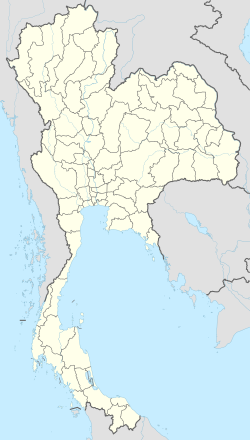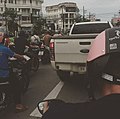Phuket (city)
Coordinates: 7°53′17″N 98°23′51″E / 7.88806°N 98.39750°E
Phuket
ภูเก็ต | |
|---|---|
| City of Phuket เทศบาลนครภูเก็ต | |
 Phuket | |
 Flag  Seal | |
 Phuket Location in Thailand | |
| Coordinates: 7°53′17″N 98°23′51″E / 7.88806°N 98.39750°E | |
| Country | |
| Province | Phuket Province |
| District | Mueang Phuket |
| Government | |
| • Type | City Municipality |
| • Mayor | Somjai Suwansupana |
| Area | |
| • City Municipality | 12 km2 (5 sq mi) |
| • Metro | 224 km2 (86 sq mi) |
| Population (2020) | |
| • City Municipality | 79,308 |
| • Density | 6,600/km2 (17,000/sq mi) |
| • Metro | 250,474 |
| Time zone | UTC+7 (ICT) |
| Area code | (+66) 12 |
| Geocode | 8399 |
| Website | phuketcity |
Phuket (/puːˈkɛt/ poo-KET; Thai: เทศบาลนครภูเก็ต or ภูเก็ต, pronounced [pʰūː.kèt]) is a city in the southeast of Phuket Island, Thailand. It is the capital of Phuket Province. As of 2020 the city had a population of 79,308. It covers the subdistricts (tambons) Talat Yai (Thai: ตลาดใหญ่) and Talat Nuea (Thai: ตลาดเหนือ) of Mueang Phuket District.
Phuket is 862 km (535.6 mi) south of Bangkok.[1]
History[]
Phuket is one of the oldest cities in Thailand.[citation needed] It was an important port on the west of the Malay Peninsula where Chinese immigrants first landed.
Phuket Old Town is a quarter studded with heritage buildings in ten streets: Klang, Phang Nga, Rassada, Dee Buk, Krabi, Thep Kasattri, Phuket, Yaowarat, Satun, and Soi Rammanee. These older buildings show Phuket town's former prosperity. They were constructed when tin mining was an important industry on the island. Their architectural style is called "Sino-Portuguese", characteristic of which is a single or two-storey building with a narrow front compensated for by considerable depth. The tiles, doors, perforated windows, and other details are all influenced by Chinese and European styles combined.[2] "Phuket Old Town" is a 2.7 km2 area covering a total of 210 rai.
As of 2019, the Fine Arts Department and the Phuket provincial authorities are preparing a proposal to the United Nations Educational, Scientific and Cultural Organisation (UNESCO) for Phuket Old Town to be listed as a World Heritage Site.[3]
In 2004 the town was elevated to city status (thesaban nakhon, Thai: เทศบาลนคร).
Culture[]
This section needs expansion. You can help by . (June 2011) |
The major religion is Buddhism. The Buddhist temples in the city are attractive destinations for national and international tourists. Along the streets some Hindu temples depicting the statues of Ganesha and Brahma can also be seen.
Demographics[]
Since 2005, the population of Phuket has been increasing.[4]
| Estimation date | 31 Dec 2005 | 31 Dec 2010 | 31 Dec 2015 | 31 Dec 2019 |
|---|---|---|---|---|
| Population | 74,208 | 75,720 | 78,421 | 79,308 |
Transportation[]
Sister cities[]
Photos[]
References[]
- ^ "Phuket". Tourism Authority of Thailand (TAT). Archived from the original on 5 July 2013. Retrieved 30 May 2015.
- ^ "Chino-Portugal Architecture Building". Tourism Authority of Thailand (TAT). Archived from the original on 29 October 2015. Retrieved 30 May 2015.
- ^ Chuenniran, Achadtaya (21 September 2019). "Old Town Phuket earns praise". Bangkok Post. Retrieved 21 September 2019.
- ^ "THAILAND: Major Cities, Towns & Communes".
- ^ "Phuket and Penang become twin cities". Phuket Gazette. 2014-09-18. Retrieved 29 September 2018.
External links[]
 Phuket Town travel guide from Wikivoyage
Phuket Town travel guide from Wikivoyage
| Wikimedia Commons has media related to Phuket (city). |
- Forbes, Andrew, and Henley, David, Phuket's Historic Peranakan Community
- Phuket City official website (in Thai)
- Populated places in Phuket Province
- Cities and towns in Thailand
- Andaman Sea
- Ports and harbours in Southeast Asia
- Port cities in Asia
- Port cities and towns of the Indian Ocean
- Southern Thailand









